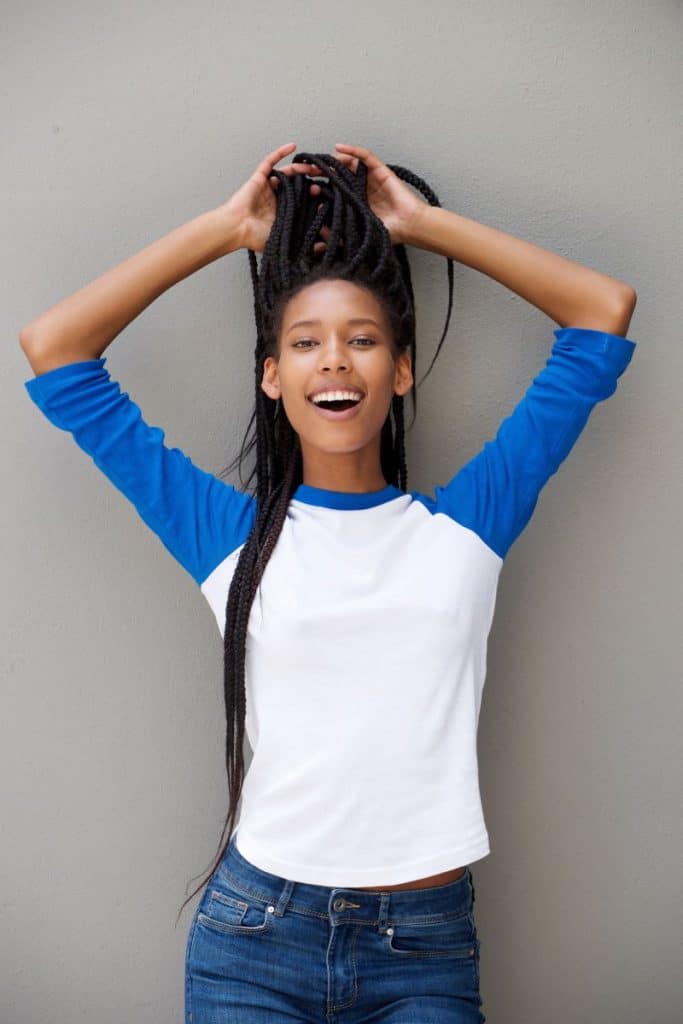Last Updated on December 18, 2022 by Vera Aduongo
Written by Vera AduongoIt’s hard not to love crochet braids! They’re versatile, affordable, a great protective style, and they’re so easy to do, even by yourself. But you’re probably wondering what caring for your crochet braids will look like because when something sounds this good, you’re used to it not being true. That said, they really don’t take much work to maintain. So, today, we’ll run you through the basics plus how to troubleshoot some of the most common problems that people have when they wear crochet braids. After this, you’ll probably be a guru on all things crochet braids.
How Long Do Crochet Braids Last?
Generally, they should last anywhere from 3 to 8 weeks. Some styles last longer than others, though. If you get any form of looser waves such as water waves or presto curls, then you can expect it to last on the lower side. If you crochet passion twists, box braids, faux locs, etc., then you can keep those in for much longer. Just retouch your roots occasionally, and you can get away with 6 to 8 weeks easily. Plus, you can reuse your passion twists, box braids, or Senegalese twists a couple of times.

I have had a pack of crochet box braids for the last 3 years that I’ve worn three times for about 4 to 8 weeks at a time. Now, I’m going to wash them tomorrow and install them again. So a good pair really is worth the investment!
How to Wash Crochet Braids?
My personal method? I tie my hair out of the way (in a loose bun at the top of my head), and then I shampoo just my roots.
Pro tip: Use diluted shampoo because neat shampoo is difficult to get out of the hair. So mix 1 part of shampoo with 2 parts of water, preferably in a bottle with an applicator.
Apply it to your roots and rub your parts gently with the tips of your fingers (not your nails). Then rinse it off thoroughly with plain water. Gently pat your roots with a towel so that any excess water is absorbed, and then you can either air dry, blow dry, or diffuse your roots. Whatever you do, make sure your hair has fully dried as soon as possible. Otherwise, you get a moldy smell that’s almost impossible to get out.
If your crochet style requires you to use mousse and other styling products to maintain it, then you will have to wash the crochet hair too. So, you’ll have your hair down, and you’ll shampoo both your roots and your crochet hair.
If you decide to use a regular conditioner, remember to dilute it as well and rinse it out thoroughly.
How to Keep Crochet Hair from Slipping or Coming Out?
With some kinds of hair, your crochet knots can become loose after installation and begin to slip off of your cornrows. You’re most likely to face this issue if the crochet hair has a looser texture or if the style is very short. Because I’ve never used hair that had a loose texture or worn a super short crochet style, I’ve personally never had to deal with this problem. But you know I gatchy! So here’s what I found out:
During installation, aim to knot the hair 2-3 times at the base. There are lots of different types of knots, including the Figure 8 knot that can keep the knots at the base of your crochet hair from unraveling altogether. But if you’re not willing to learn a new method, then you can use hair spray to hold them in place.
Once you’re done crocheting the hair onto your braids, pull your hair taut to tighten the knots, and then spray some hair spray right on the knots. Place a clip right above the knots to hold them in place until they dry. There are other methods, but this is the easiest, safest, and least time-consuming method I found.
How to Maintain Crochet Braids at Night?
It’s easy to take for granted just how much we move in our sleep. We can be tossing and turning 40-50 times a night in our sleep. That’s a loot! Now, imagine all the friction your hair is experiencing if it’s rubbing against a cotton or polyester pillowcase. Your hairstyle will become frizzy in no time.
To maintain your crochet braids at night, you, therefore, want to gather your hair into a pineapple or low bun and then cover that with a bonnet or satin scarf. If it’s a scarf or an adjustable bonnet, just make sure to tighten it enough so that it won’t come off in your sleep. Just don’t make it too tight, or you’ll give yourself a headache.

How to Keep Crochet Braids from Frizzing?
Ultimately, the ends of your hair will get tangled. That’s just how synthetic hair is. So, every week, you should go in and trim any knots at the ends of your hair and cut out any loose strands of synthetic hair along the length of the crochet hair. Doing this will help your style look neater for longer. However, depending on the hair texture, you’ll need a couple more steps to keep your crochet hair from frizzing.
For loose wavy or curly textures, including passion or spring twists, you’ll need to use a styling product to help tame the frizz. My favorite is mousse, but interestingly, you can also use a fabric conditioner/softener mixed with water. After snipping away flyaways and tangled ends, spray your hair with water or the water and conditioner mix. If you use water, you would apply your mousse right after this. Then smooth that into your hair and slowly separate any curls that have still clamped together.
For box braids or Senegalese twists, you can dip your hair into hot water. With traditional braiding hair, dipping it in hot water reduces frizz and improves the overall movement of the hair. It’s the same with the crochet braid versions. The only caveat is if you choose to do the individual box braids crochet method, then make sure to dip only the sections that are below where your actual hair ends. The section above that should be maintained using mousse and trimming any flyaway strands.
See, I told you that you’d be a guru by the end of this! Here’s to slaying those crochet braids for even longer!
Stay tuned for our article specifically on faux locs and butterfly/distressed locs and how to care for them.

Vera Aduongo is a seasoned writer whose journey was sparked by her own hair journey. When she looked on the internet and found a few sources that catered to her hair type, she started to share what she knew. First, with family and friends, and soon, with the ‘internets’. 7 years later, with a mane to boot, she’s not looking back! When she’s not contributing to a topic on natural hair and hair extensions, you can find her writing for Retail & Consulting brands, trying out new restaurants, binge-watching YouTube, and being an aunt to the 2 most handsome boys out there (IMO).
Vera lives in Nairobi, Kenya.

